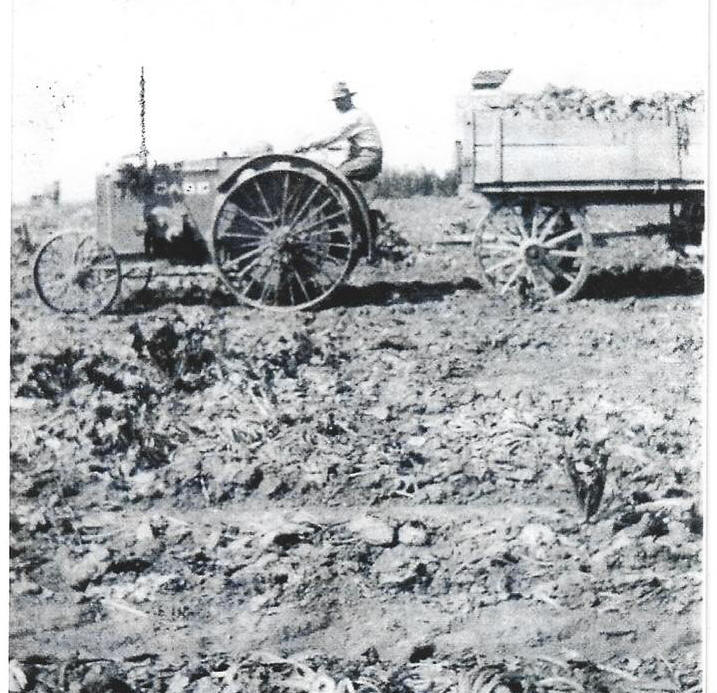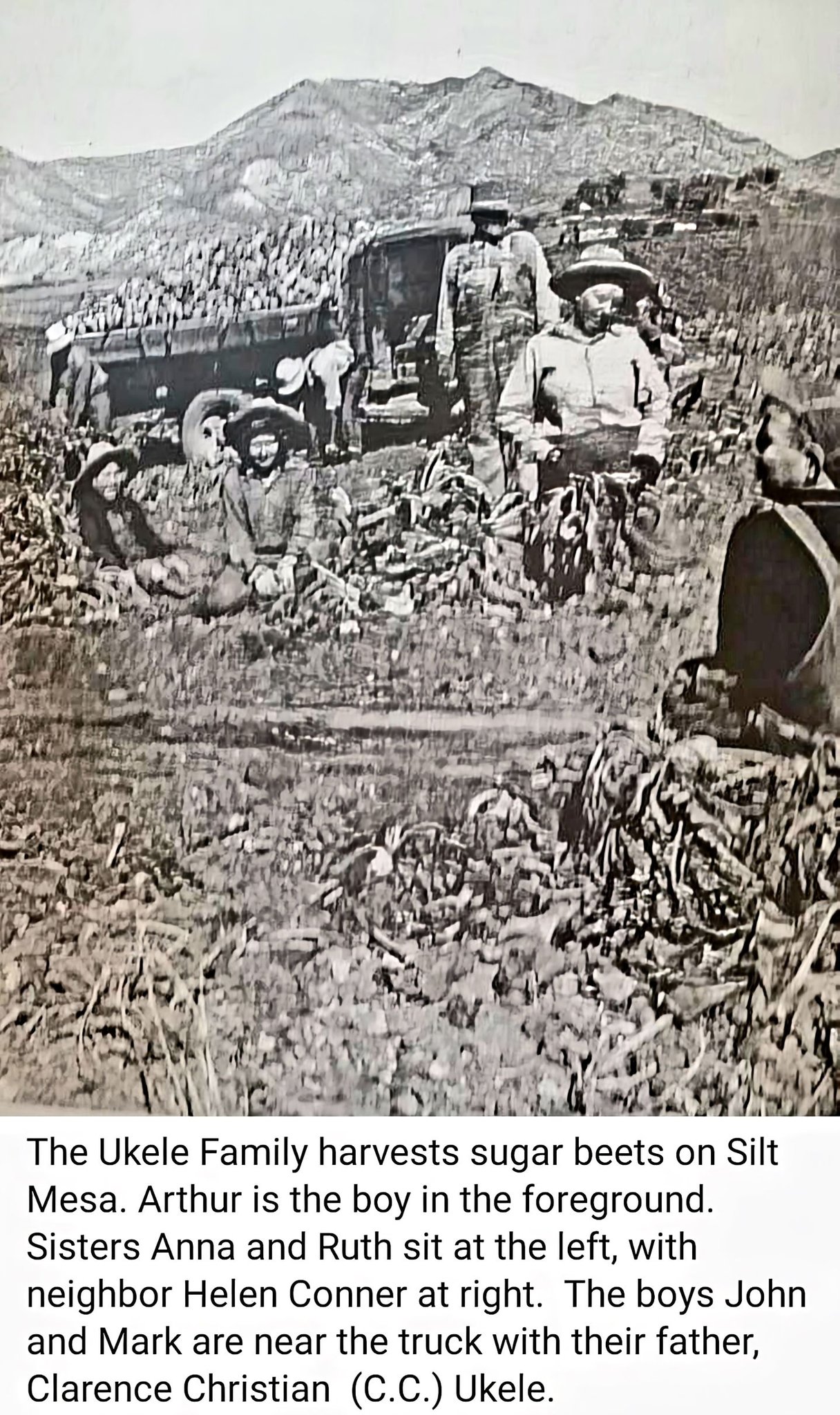
 Dick
Cozza's Grandfather on the tractor
Dick
Cozza's Grandfather on the tractor
Harvesting Beets In The Early Days
By Mrs. Percy Sheets, The Daily
Sentinel, November 21, 1954
Another beet harvest in the. Lower Valley
is almost finished, it was a big harvest and yet the shortest one ever
handied due to the speedy mechanical equipment used.
In looking back
over the past 36 years and reviewing the changes since everything was
done by horse and hand labor, one marvels at the pluck, tolerance and
patience beet growers had to have in the early days of farming under the
Grand Valley and High Line Canals.
Sugar beets were raised as far
back as 1902 under the Grand Valley Canal. Holly Sugar Corp, which owned
much of the Lower Valley land under irrigation, shipped Russians and
Japanese from the Eastern Slope to do the thinning, hoeing and topping;
but it was in 1918 that beet growing was started on a big scale.
That
year the High Line Canal was officlally opened, bringing many thousands
of acres of desert under Irrigation and bringing a host of new families
into different communities.
In fact, three new country schools were
started to accommodate the many children. One was northwest of Mack in
the Big Basin or New Liberty district, which was newly established;
another was northwest of Loma called Valley View School; and the third,
built northeast of town, was called Sunset School.
Sugar beet acreage
became so large the Holly Sugar Corp. opened an office at Loma and hired
a field man to look after the crop planting, harvesting, and labor in
the west end of the valley.
Several new dumps were built besides
those already in use at Loma and Fruita.
One, known as the
"Clarkson," was erected 4 1/2 miles west of Mack on the Unitah Railroad.
Beets raised in the New Liberty district were hauled there. Another one
was built just south of Enterprise School and a spur track of 6 miles
was laid to it from the interurban line: and the "Stoner'' dump in the
Hunter district was erected on this line.
Yield was much smaller then
due to new land conditions and inexperience in crop raising and
irrigating. About 9 or 10 tons
per acre, according to different
farmers of those days, was a fair average.
Mexican labor was used
mostly then and they were paid so much an acre for thinning, hoeing and
topping.
Haulers using teams and beet wagons were paid 50 cents a
ton for loading the beets in the field onto the wagon with a beet fork
(hand implement) and hauling them to the dump.
Hauling in those days
was a hard, slow job. All country roads were ungraded and unsurfaced.
Before rains the dust ruts were deep and rough, and after a heavy fall
rain or early snow, the ruts became bottomless mud
wallows,
Then
it would oft` times take two teams to get a load of beets to the scale
house and up over the slick or icy board dump ramps.
Most any night
from early in October until late December the street of Loma and the
highway along the dump were lined with loads of beets that got in too
late to be weighed and dumped before dark.
There was no way of
lighting the ramps in those days so team and wagon could be taken over
them. The hauler Just had
to park his load, and iake his team back
home perhaps 6 or 7 miles away and come back at daybreak io wait his
turn to get unloaded.
Many a time a huge steam engine and freight
train would go by with an ear-splitting whistle and roar while a load
was being dumped causing the horses to bolt down the ramp carrying the
half empty wagon with them and wrecking the driver's nerves and things
in general.
The dumps were some 18 feet high with long sioping ramps
in opposite directions. The structure was entirely of wood.
After
being weighed on a scales nearby in a tiny house, the wagon of beets was
pulled up one of these ramps to a platform at the top.
There a dump
man hoisted one side of
the beet box with a crank and cable, opened
the lowered side which was on hinges thus permitting the beets to plunge
out of the box down into a shute which led to a railroad car on the side
track.
While this was being done, another man caught a basket of the
beets being dumped, took them into a tiny room off the platform, and
removed all the dirt from them with a wire brush. This dirt he then
weighed to estimate the tare of the load.
After all the beets were
out of the wagon, it was taken down the other ramp and reweighed.
Sometimes rail cars were unavailable to take the beets into the Grand
Junction factory, and the beets would have to be unloaded by hand by the
hauler. There were enormous piles of them north of the highway and west
of Loma.
The sugar company had a scales put in at the Kinsey place
three miles north of Loma permitting the faraway growers to haul beets
there and dump them. These all had to be reloaded by hand and hauled to
the dump later in the winter.
If winter started in December and the
ground froze some beets couldn't even be dug,
If you have questions, contributions, or problems with this site, email:
Coordinator - Rebecca Maloney
State Coordinator: Colleen Pustola
Asst. State Coordinators: Rebecca Maloney - Betty Baker - M.D. Monk
If you have questions or problems with this site, email the County Coordinator. Please to not ask for specfic research on your family. I am unable to do your personal research.
